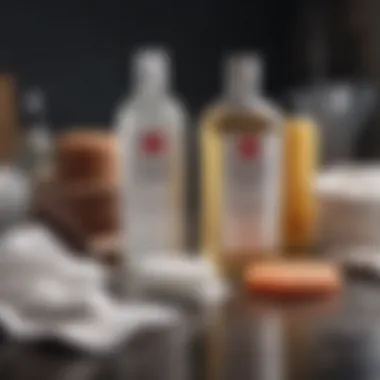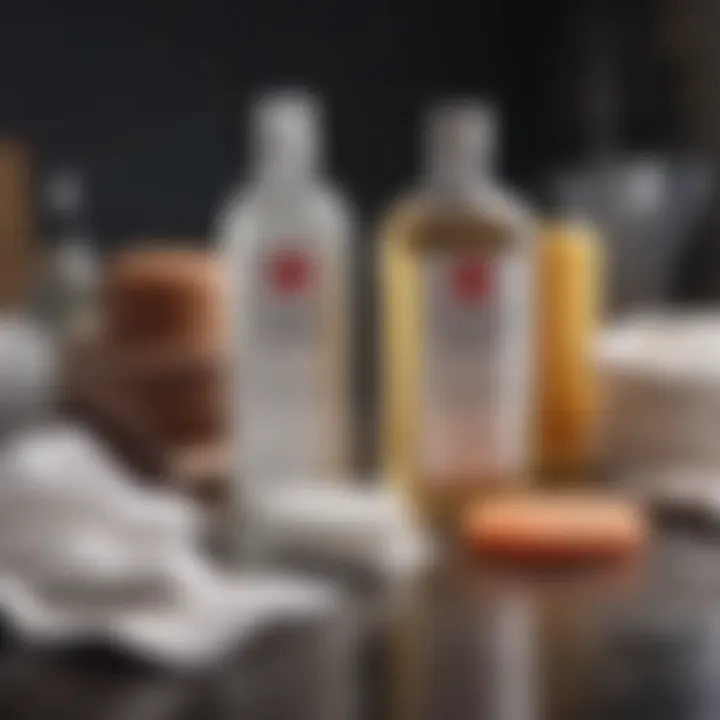Effective Techniques for Removing Stains from White Shirts


Intro
Maintaining the pristine condition of white shirts is a challenge for many. Stains can occur unexpectedly and can range from food spills to ink marks. Each type of stain requires a specific approach to ensure effective removal without damaging the fabric. This article aims to provide a systematic guide on various effective techniques for stain removal, offering insights into appropriate cleaning materials and procedures. By understanding the nature of stains and the correct methods for treating them, individuals can preserve the integrity of their favorite garments.
Types of Stains
Understanding the type of stain is crucial for determining the most effective removal technique. Common types of stains on white shirts include:
- Food and Beverage Stains: These can include grease, oil, coffee, or wine.
- Ink Stains: Often found from pens or markers, these can be quite stubborn.
- Blood Stains: These require prompt action for effective removal.
- Sweat and Deodorant Marks: These can lead to unsightly yellowing over time.
Identifying the Stain
Before acting, identify the stain type carefully. This step involves:
- Checking the fabric label for specific care instructions.
- Noting how long the stain has been present, as older stains are harder to remove.
- Assessing the fabric type, as different materials may react differently to the same cleaning method.
Cleaning Materials
Having the right cleaning materials is essential for effective stain removal. Here are some commonly used items:
- Liquid Detergents: A general purpose stain remover.
- Fels-Naptha Soap: Useful for greasy stains.
- White Vinegar: Natural stain remover and deodorizer.
- Baking Soda: Acts as an abrasive and can help lift stains.
- Hydrogen Peroxide: Useful for whitening and spot treating.
How to Use Cleaning Materials
Each cleaning material has a unique application method. Consider following these general principles:
- Test a small area of fabric first to check for colorfastness.
- Applying the chosen cleaning product directly on the stain, letting it sit for a few minutes.
- Gently rubbing the area with a soft cloth or brush (if applicable) to aid in lifting the stain.
Step-by-Step Stain Removal Techniques
Each type of stain has a tailored approach:
Food and Beverage Stains
- Blot the stain gently with a cloth, do not rub it in further.
- Rinse under cold water before applying detergent.
- Let it sit for at least 5 minutes before rinsing and washing as usual.
Ink Stains
- For Fresh Ink:
- For Dried Ink:
- Blot the stained area with rubbing alcohol.
- Rinse under cold water and apply detergent.
- Soak the fabric in milk overnight.
- Wash as normal afterward.
Blood Stains
- Rinse the stained area under cold water immediately.
- Apply a mixture of water and hydrogen peroxide to treat the stain.
- Rinse again and wash as necessary.
Sweat and Deodorant Stains
- Create a paste of baking soda and water to apply to affected areas.
- Let it sit for at least 30 minutes before washing.
Remember: Always wash white shirts in cold water. Hot water can set stains instead of removing them.
Culmination


Removing stains from white shirts is a process that can be mastered with time and familiarity with the right techniques. This guide aims to empower readers with a systematic approach to stain removal, ensuring their white shirts remain a staple in their wardrobe for years to come. Through careful attention to the type of stain and application of effective cleaning materials, one can tackle almost any stain with confidence.
Preface to Stain Removal
Stains on white shirts present a significant challenge for anyone who values their appearance. White clothing is a classic in fashion, often favored for its versatility and freshness. However, maintaining that pristine look requires a proper understanding of stain removal techniques. This article aims to inform readers about effective methods and practical approaches for handling various types of stains on white shirts.
Effective stain removal is not just about aesthetics. Each overlooked stain has the potential to deteriorate the fabric over time, leading to irreversible damage. Therefore, an understanding of when and how to address these marks is essential. Readers will benefit from grasping essential cleaning agents and techniques to ensure their garments last longer while looking their best.
Moreover, educating oneself on stain treatment will prevent future mishaps. Often, the method used to treat a stain differs depending on its type. Armed with the right knowledge, individuals can navigate potential pitfalls. This section will serve as a foundation for the subsequent discussions on specific stains and removal techniques.
Gathering Necessary Supplies
The process of stain removal from white shirts starts with one crucial step: gathering necessary supplies. An effective cleaning strategy requires correct materials and tools. Collecting these items beforehand not only streamlines the stain removal process but also ensures that the right resources are at hand when needed.
Having appropriate supplies can greatly influence the outcome. Different stains require different treatments. Familiarity with these materials allows the user to act efficiently and avoid any potential mishaps. Moreover, knowing what to use reduces anxiety, resulting in a more focused and attentive approach to stain treatment.
Essential Cleaning Agents
In any stain removal process, essential cleaning agents play a vital role. These agents include substances like liquid laundry detergent, baking soda, white vinegar, and hydrogen peroxide. Each one has unique properties that make them effective against specific types of stains.
- Liquid Laundry Detergent is effective for many common stains. Its surfactants penetrate and lift stains from fabric.
- Baking Soda serves as a gentle abrasive. It is particularly useful for deodorizing and removing tough stains when used in a paste.
- White Vinegar acts as a natural disinfectant and can help dissolve certain stains, especially those caused by food.
- Hydrogen Peroxide can be a powerful bleaching agent. It is important to use it cautiously to prevent damage to the fabric.
Knowing these cleaning agents and their applications can empower users to take on challenging stains effectively. Always check fabric care labels before using these agents to manage fabric sensitivity and prevent damage.
Tools Required for Stain Removal
In addition to cleaning agents, specific tools are essential for an efficient stain removal process. Tools help in applying these agents effectively and managing stubborn stains.
Some necessary tools include:
- Soft Bristle Brush or Toothbrush: Ideal for gently scrubbing stains without damaging the fabric.
- Clean Cloths or Paper Towels: Useful for blotting stains before applying any cleaning agent.
- Spray Bottle: A handy tool for applying cleaning solutions evenly without soaking the fabric.
- Plastic Scraper: Necessary for removing any dried material without causing fabric tears.
Equipping oneself with these tools ensures the user is prepared to tackle any stain. When combined with the right cleaning agents, they form a comprehensive approach to maintaining white shirts. Planning ahead in this manner increases the chances of successful stain removal.
Pre-Treatment Stain Assessment
Pre-treatment stain assessment is a crucial step in the stain removal process. The effectiveness of any stain removal technique largely depends on how well you understand the nature of the stain and the fabric involved. Identifying these elements can significantly enhance your chances of successful cleaning while preventing unintended damage to your white shirts.
Identifying the Stain Type
Correctly identifying the stain type is fundamental for effective treatment. Different stains require specific approaches to remove them without causing fabric damage. Here are common types of stains you might encounter on white shirts:
- Protein stains: These include blood, sweat, or food like eggs and dairy. They typically require cold water treatment.
- Fat stains: These come from oils or greasy foods and often need a degreaser for effective removal.
- Dye stains: Ink or colorful beverages fall into this category and may necessitate gentle cleaning solutions.
- Tannin stains: Derived from coffee, tea or wine, these stains often require a specific treatment to lift them off the fabric without leaving a residue.
Identifying the stain type not only aids in selecting the right cleaning solution but also influences the effectiveness of your chosen technique. For instance, applying hot water on protein stains can cause them to set further into the fabric, making removal much harder.
Testing Fabric Sensitivity
After identifying the stain type, testing fabric sensitivity before applying any cleaning solution is essential. Not all fabrics react the same way to stain removers or cleaning solutions. Here are some points to consider when testing fabric sensitivity:
- Conduct a patch test: Apply a small amount of the cleaning solution to a discreet area of the fabric. Wait for a few minutes to observe any discoloration or damage.
- Check fabric care labels: Most clothing has care labels that provide guidance on washing methods and appropriate cleaning agents. These labels can help in deciding what treatments to avoid.
- Identify the fabric type: Natural fibers like cotton might react differently compared to synthetic fibers such as polyester. Knowledge about the specific fabric ensures that you don’t use harsh chemicals that could degrade its quality.
Method-Specific Stain Removal Techniques
When it comes to maintaining the pristine condition of white shirts, understanding method-specific stain removal techniques is essential. Each stain presents unique challenges that require tailored approaches for effective removal. The importance of these techniques lies in their ability to target specific stains without damaging the fabric.
Employing the right methods minimizes the risk of discoloration or fabric degradation. Moreover, knowing the specific cleaning approach for particular stains saves time and enhances the overall effectiveness of the cleaning process. For instance, approaches that work for food stains may not be suitable for ink or dye stains. A structured strategy enables one to act confidently, preventing frustration and preserving the integrity of white clothing.


Removing Food Stains
Food stains are among the most common challenges faced when it comes to white shirts. These stains often come from substances like sauces, fruits, and beverages. The first step is to act quickly, avoiding the stain setting in.
- Blot the Stain: Use a clean cloth to gently blot the stain. This absorbs excess liquid, which is crucial for successful removal.
- Cold Water Rinse: Next, rinse the fabric under cold water. This helps in loosening the stain particles from the fibers.
- Stain Treatment: Apply a suitable stain remover or laundry detergent directly onto the food stain. Products like OxiClean MaxForce or Zout can be effective.
- Gentle Scrub: Using a soft-bristled brush or your fingers, gently scrub the area to allow the cleaning agent to penetrate.
- Final Wash: After treatment, wash the shirt in cold water as per fabric instructions. Check thoroughly before drying, as heat can set any remaining stains.
Cleaning Grease and Oil Stains
Grease and oil stains can be particularly stubborn on white fabric. These types of stains often result from cooking or accidental spills. In tackling these stains, the goal is to break down the oil molecules effectively.
- Immediate Action: Quickly blot the stain with a paper towel to absorb excess oil. Avoid rubbing, as this can spread the stain.
- Talcum Powder or Cornstarch: Sprinkle a generous amount of talcum powder or cornstarch on the stain. This helps absorb the grease. Let it sit for about 15 minutes before brushing it off.
- Dish Soap Application: Use a few drops of dishwashing liquid, known for cutting grease. Gently rub it into the stain with your fingers.
- Rinse and Wash: Rinse the area with cold water and proceed to wash the shirt according to the care label instructions.
- Inspect Before Drying: Always check the stain after the wash. If the stain persists, repeat the process before drying the shirt.
Addressing Ink and Dye Stains
Ink and dye stains present a unique challenge due to their chemical composition. These stains can originate from pen leaks or color transfers. Addressing them requires a careful approach to avoid spreading.
- Place Paper Towels: Position paper towels under the stained area to prevent ink transfer to other parts.
- Alcohol-Based Cleaner: Dab a cotton ball or cloth in rubbing alcohol or hand sanitizer. Gently blot the stain, working from the outer edges inward to avoid spreading.
- Rinse Thoroughly: Rinse the treated area with cold water. This helps to remove excess ink.
- Check for Success: The stain may need repetition of the alcohol treatment. Be patient and check the progress before washing.
- Final Wash: After treatment, wash as per fabric guidelines to remove any remaining residue.
Remember: It is crucial to always conduct a patch test prior to applying any cleaning solution on a less visible area of the fabric to avoid potential damage.
General Stain Removal Procedures
Understanding the general procedures for stain removal is crucial when managing the maintenance of white shirts. This section outlines fundamental techniques that are effective for multiple stain types. The rationale behind following specific procedures lies in ensuring that stains are treated appropriately without causing damage to the fabric. Adhering to these methods optimizes the outcome and extends the lifespan of shirts.
Cold Water Rinse Process
The cold water rinse is often the first step in stain treatment. It serves to remove surface stains before any cleaning solutions are applied. Using cold water is critical, as hot water can sometimes set a stain, making it more challenging to remove. The temperature of the water can have significant impact on the effectiveness of the removal process.
- Steps for Cold Water Rinse:
- Immediately Rinse: As quickly as possible, rinse the stained area with cold water. This helps lift the stain from the fabric.
- Direct Water Flow: Rinse from the back of the fabric to push the stain out, rather than rubbing the stain deeper.
- Assess the Stain: If the stain persists, note its characteristics before applying any cleaning agent.
Following this rinse step ensures that you’re not inadvertently setting the stain into the fabric.
Applying Cleaning Solutions
After the initial rinse, selecting the appropriate cleaning solution is the next phase. This involves identifying the right product that corresponds to the type of stain being dealt with, whether it be food, grease, or ink. Proper application of cleaning solutions is vital; the wrong type can damage the fabric or leave residue.
- Considerations for Cleaning Solutions:
- Choose based on the Stain Type: For instance, use enzyme-based cleaners for protein stains and alcohol for ink stains.
- Dilute when Necessary: Concentrated solutions can be harsh. Dilution can avoid fabric damage while still effectively removing stains.
A well-chosen cleaning solution can significantly reduce the effort needed to remove the stain.
Scrubbing Techniques for Effective Cleaning
Once a cleaning solution is applied, scrubbing becomes essential to work the solution into the fabric. However, technique is everything. Rubbing too aggressively can weaken the fabric fibers, resulting in wear and tear.
- Effective Scrubbing Techniques:
- Use a Soft Brush or Cloth: A soft-bristled brush or clean cloth is gentler on fabrics while still providing the necessary agitation.
- Gentle Circular Motions: Instead of scrubbing back and forth, use gentle circular motions; this minimizes damage and enhances the solution's effectiveness.
- Use the Right Amount of Pressure: Apply just enough pressure to lift the stain without compromising fabric integrity.
Implementing these general procedures helps ensure that white shirts remain pristine. They serve as a foundation for more specific stain removal methods addressed throughout the article.
Post-Cleaning Care


Post-cleaning care is a critical step in maintaining the quality and longevity of white shirts. Even after the most thorough stain removal process, there are additional tasks to ensure your garments remain pristine. Neglecting post-cleaning care can lead to the recurrence of stains, fading, or deterioration of fabric quality. Therefore, it is essential to adopt specific practices that extend the life of your clothing while keeping it looking fresh.
Checking for Residual Stains
After the initial cleaning procedures, checking for residual stains is vital. Stains may not always disappear after one treatment, especially those that are ingrained in the fabric. Inspect the shirt under natural light to detect any remaining discolorations. Pay close attention to common problem areas such as collars, cuffs, and underarm sections.
- Gently rub the area with a clean cloth. This can help reveal hidden spots that may need further attention.
- Use a stain remover for persistent stains. If any traces remain, consider applying a bit of the appropriate cleaning solution. This should be done carefully to avoid damaging the fabric's fibers.
- Rewash if necessary. Sometimes a second washing is required. Make sure to handle this correctly, based on the type of stain and the fabric materials.
Proper Washing Method
The proper washing method following stain treatment concludes the cleaning process effectively. Once you ensure there are no remaining stains, washing the shirt neatly will help restore its overall brightness.
- Use a gentle cycle. Set your washing machine to a delicate cycle to minimize wear on the fabric.
- Choose the correct temperature. Cold water is preferred for white shirts, especially if they are adorned with delicate fabrics. Hot water, while effective on some stains, can set others.
- Select a mild detergent. Using a detergent specifically designed for whites helps maintain brightness and prevents yellowing.
In cases where the shirt has significant stubborn stains, pre-soaking in a detergent solution can be beneficial before the actual wash.
Drying Techniques to Avoid Damage
Finally, understanding drying techniques to avoid damage is crucial in the post-cleaning care phase. Improper drying can lead to fading, shrinkage, or even misshaping of your shirts.
- Air drying is ideal. Hang the shirt on a line or a hanger in a shaded area. Direct sunlight can cause the fabric to deteriorate or yellow over time.
- Avoid wringing or twisting. This can distort the shape of the shirt. Instead, gently press water out by pressing the shirt against the side of the sink.
- Tumble drying should be approached with caution. If necessary, use a low heat setting, but be mindful that it may affect the fabric's longevity.
In summary, adopting a diligent post-cleaning care routine will significantly affect the longevity and appearance of your white shirts. Regular checks for residual stains, careful washing practices, and appropriate drying methods are key components in preserving their pristine quality.
Preventative Strategies
Stain removal is often seen as a reactive process. However, adopting preventative strategies can significantly reduce the occurrence of stains on white shirts, ultimately preserving their appearance and extending their lifespan. Understanding how to prepare and care for white fabrics can prevent significant damage and make the cleaning process more manageable. This section discusses the elements and benefits of effective preventative measures that clothing owners should consider.
Choosing the Right Fabrics
Selecting the appropriate fabric plays a vital role in reducing stain visibility and the ease of cleaning. Some materials are inherently more stain-resistant than others. For example, cotton fabrics tend to absorb stains easily due to their porous nature, while synthetic fabrics, like polyester, repel liquids better, making them less prone to staining. When purchasing white shirts, it's wise to look for fabrics that feature a tight weave, as they can better resist dirt and liquids.
Additionally, some manufacturers treat their fabrics with special stain-resistant coatings. Hence, choosing brands that offer such options can further decrease the likelihood of stains setting in. It is also beneficial to observe fabric care labels and choose shirts that specify easy-care or stain-resistant properties.
Best Practices for White Shirt Care
Once you have selected the right fabric, implementing best practices in shirt care will further enhance stain resistance. Here are some key strategies:
- Regular Washing: Wash white shirts frequently to prevent dirt buildup. Ensure that you wash them separately or with similar colors to avoid discoloration.
- Cold Water Rinse: Whenever possible, begin with a cold water rinse before applying any cleaning agents. This helps to prevent stains from setting.
- Avoid Fabric Softeners: Fabric softeners can leave a layer on fabrics, potentially trapping dirt and stains. Instead, stick to detergents that suit your fabric type.
- Prompt Stain Treatment: Address any stains immediately. The faster you act, the better chance you have of removing the stain completely. Use cold water and blot the area with a cloth.
- Air Drying: Whenever feasible, let white shirts air dry instead of using a dryer, which can set any remaining stains. Sunlight also naturally brightens fabrics.
"Prevention is better than cure.” Emphasizing care and prevention will result in less time spent worrying about stubborn stains.
Finale
Understanding the techniques for removing stains from white shirts is vital for maintaining both the appearance and longevity of your clothing. White shirts, despite their versatility and elegance, are notorious for showing stains. This article has provided various effective methods to tackle these challenges through timely intervention and detailed stain management.
Summarizing Key Stain Removal Steps
First and foremost, knowing how to identify the type of stain is essential. Different stains require specific approaches. The primary steps include:
- Pre-treatment: Assess the stain and determine the appropriate cleaning agent. This step often dictates the success of the stain-removal effort. Chemical interactions differ greatly between substances like wine, grease, and ink.
- Application of Cleaning Solutions: Once the right product is chosen, apply it directly to the stain. Allow it to soak in for a short period to enhance its effectiveness. This pre-treatment can make all the difference in the final outcome.
- Scrubbing Techniques: Use a gentle scrubbing method to lift the stain from the fabric. It is crucial to avoid excessive force which can damage the shirt's fibers.
- Checking for Residual Stains: After washing, ensure that the stain is completely gone before drying. This prevents setting the stain, which can occur with high heat.
- Proper Washing and Drying: Follow recommended methods for washing white shirts. On occasions, air drying may be more beneficial in preserving fabric integrity compared to tumble drying.
These steps emphasize that a systematic approach can lead to higher success rates when dealing with stubborn stains.
The Value of Maintenance in Wardrobe Care
Maintaining your wardrobe, particularly white shirts, involves more than just immediate stain treatment. Regular care extends the life of your garments and keeps them looking their best.
- Choose the Right Fabrics: When purchasing new shirts, consider high-quality materials that resist staining and maintain color. Fabrics like cotton blended with synthetic fibers can have stain release properties which could save you time and effort later.
- Implement Best Practices: Regular washing at appropriate intervals and following care labels can preserve fabric structure and prevent premature aging. This includes avoiding overcrowding in the wash and using the correct water temperature.
- Storage Considerations: Proper folding or hanging of white shirts can also prevent unnecessary creasing or yellowing, particularly when stored for longer periods.
By prioritizing maintenance, you not only enhance the appearance of your clothing but also ensure their durability.
In summary, a structured regime for stain removal and garment care is indispensable for anyone who values their wardrobe. Arming yourself with knowledge about effective techniques can help you tackle stains proactively, allowing you to enjoy your white shirts for years to come.















